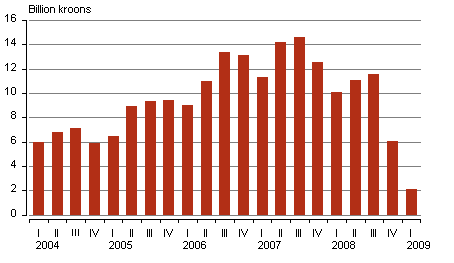Entrepreneurs’ profit decreased considerably
In the 1st quarter enterprises earned 2.1 billion kroons profit, about 8 billion less than in the same period a year before. The entrepreneurs’ profit was lower than that last in the 4th quarter of 1999, when entrepreneurs earned slightly more than a billion kroons profit.
In the 1st quarter, the activity with the biggest net sales — wholesale and retail trade — was in loss for the first time (the loss 443 billion kroons). Retail trade and sale of motor vehicles were in loss; wholesale trade had a small profit. Rising unemployment causes insecurity among the consumers and people consider their purchases more carefully. Stiff competition has put retail trade enterprises in a situation where they have to operate also with loss.
Of other activities crop and animal production, forestry, construction and accommodation and food service activities were in loss.
Total profit of enterprises, 1st quarter 2004 – 1st quarter 2009

In the 1st quarter of 2009, enterprises sold goods and services for more than 120 billion kroons at current prices, i.e. for more than a fifth less than a year ago. Wholesale and retail trade and manufacturing enterprises accounted for the biggest share in net sales, correspondingly 39% and 19% of the total volume. Net sales decreased by a fourth both in wholesale and retail trade and in manufacturing. The net sales of other biggest activities also decreased.
Similarly to net sales also enterprises’ total costs have decreased, but the decrease is smaller (17%). The biggest decline in total costs was in construction (27%) and in wholesale and retail trade (22%). Personnel expenses decreased 10% during the year.
In the 1st quarter of 2009, enterprises invested 8.5 billion kroons, 10% less than a year ago. Investments were made mainly in construction, alteration of buildings and in other equipment and machinery. Investments in acquisition of buildings and structures increased by about a third and investments in land by 41%. Other investments decreased.